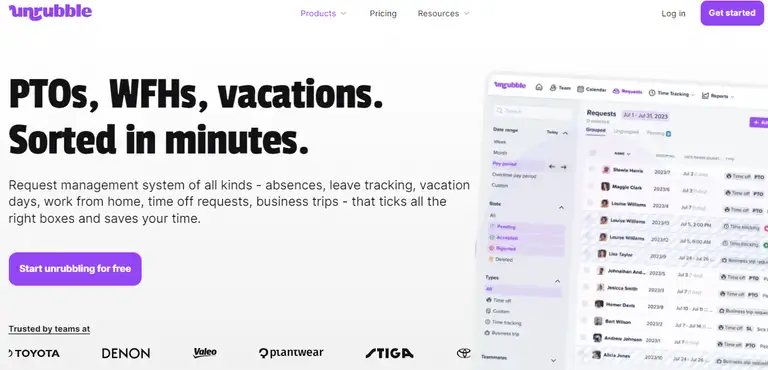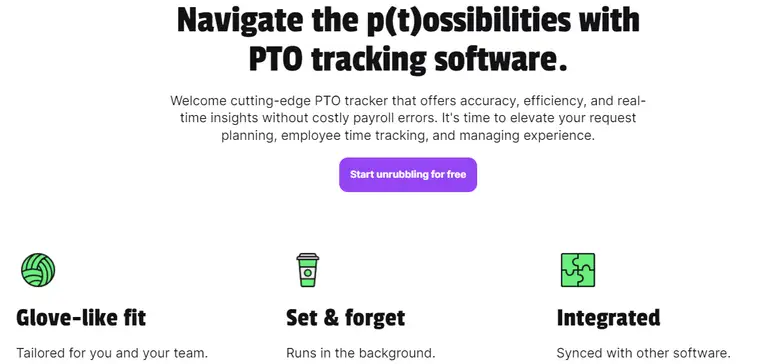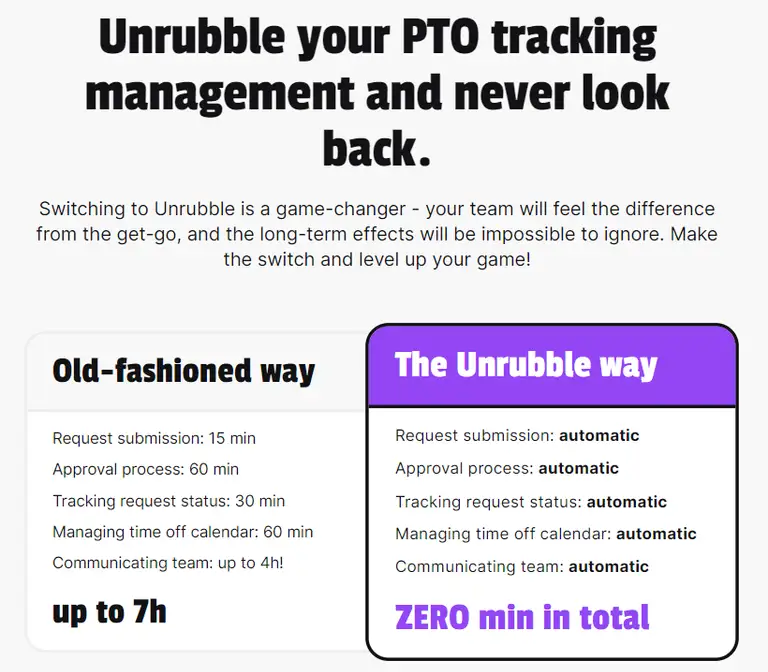When you have employees, there is more than work to think about. You also have to establish when and how they go on vacation. Not only to keep them happy but also to comply with the law.
One way to deal with their days off is through PTO accrual.
This system can simplify how time off is earned and give clear benefits to both employees and employers.
Setting it up effectively can save a lot of your headaches.
So, in this article you'll learn:
- what PTO accrual is and why you should set it up,
- how to calculate PTO accruals,
- and what you can use as an alternative.
Let's jump right in.
What is PTO accrual?

PTO accrual refers to the process by which employees earn paid time off (PTO) as they work.
Instead of receiving all their PTO days at the start of the year, workers accumulate them gradually over time. This system is common in many workplaces and helps manage when and how employees can take time off from work.
In a PTO accrual system, the amount of time off an employee earns can depend on several factors.
These might include:
- how long they have worked for the company,
- their job position,
- or the number of hours they work each week.
For example, an employee might accrue a certain number of hours or days of PTO for each month of work. This accumulated time can be used for vacations, personal days, or sick leave.
What's the idea behind it all?
The main idea behind PTO accrual is to reward employees for their work while also providing flexibility in managing time off.
As a result, employees don't use all their PTO at once, so the company can have a steady workforce throughout the year. Additionally, this system can motivate employees to stay with a company, as they can accumulate more PTO by staying longer.
Overall, PTO accrual is a way to balance the needs of the company with the needs of its employees.
Why setting up a PTO accrual policy is important
If you haven't already, you might want to set up a PTO accrual policy for the following reasons:
Fairness and equity
First of all, it's the way to fairness and equity among employees. It means that PTO accrues based on the hours worked, which in turn promotes an equal opportunity for all employees to earn paid time off.
Whether it's hourly PTO accrual or monthly PTO accrual, everyone gets a fair share based on their contribution to the company.
This approach minimizes conflicts and distributes PTO benefits justly across the organization.
Accurate tracking
A well-defined policy helps in the accurate tracking of paid time off. Each pay period, paid time off is calculated and recorded.
As such, it's easy for both employees and HR to keep track of unused accrued PTO and annual PTO hours.
Precise tracking prevents discrepancies and lets all employees know exactly how much PTO they have at any time.
Cost management
Another benefit is improved cost management.
By letting PTO accumulate over time, companies can avoid the financial burden of a large compensation payout at once if an employee leaves.
This staged approach helps manage cash flow better and makes the financial impact of giving PTO spread throughout the accrual period.
Retention and engagement
Moving forward, you can also enhance employee retention and engagement.
When employees see that they accrue PTO as a reward for their hard work and loyalty, it boosts morale and motivates them to stay with the company longer.
Additionally, knowing they have PTO to use for personal time supports a healthy work-life balance - something key for long-term worker satisfaction.
Legal compliance
A proper PTO accrual policy lets you stay compliant with local and national labor laws. Regulations often dictate how PTO must be accrued, used, and compensated.
Establishing a set of rules that align with these laws helps avoid legal complications.
Furthermore, both daily PTO accrual and weekly PTO accrual also meet statutory requirements.
Flexibility and control
The perks don't end here. Correct time off policies give you flexibility and control over how and when employees use their paid time off.
That's because employees can plan their vacations and personal days around the PTO they have accrued.
For employers, this system allows for better staffing and planning, so that not all employees take time off simultaneously unless it fits the business needs.

Mitigation of absenteeism
Last but not least, PTO policies that let employees accumulate time off gradually encourage them to plan their absences.
What does this mean for you? Reduced unexpected absenteeism.
This planned usage helps maintain productivity and promotes continuity in the workplace. A transparent policy with clear rules also reduces the likelihood of misuse of PTO. Pretty convenient, isn't it?
How to calculate PTO accruals

Calculating PTO accruals can seem like a daunting task, but with these simple steps and tips, you'll become a pro in no time.
Let's break down the process:
Determine accrual rate
Start by deciding how fast PTO should accrue.
You might set it up so that employees earn a certain number of hours per pay period, such as two hours of PTO for every 40 hours worked.
This rate can vary depending on your company policy or employment contracts.
Make it fun and fair, so your team feels valued!
Define eligibility criteria
Who gets PTO?
Is it everyone from day one, or do they have to earn their way in, like a secret club?
Set clear rules about who qualifies for accruing PTO - typically full-time employees.
You might also consider if part-time or temporary employees accrue PTO at a different rate.
Calculate accruals
Next, it's time to calculate all the accruals.
We suggest doing it like this:
- For salaried employees: Accrue PTO based on their pay periods. For example, if you offer 10 days per year, divide this by the number of pay periods to determine how much PTO is accrued each time.
- For hourly employees: Link their PTO accrual to the hours they work. This makes it transparent and keeps everyone on the same page.
Consider rounding rules
Decide how you'll round the accrued time.
Will you round up to the nearest hour, or keep it to the exact minute?
Consistent rounding rules keep things straightforward and prevent confusion.
Account for carryovers and caps
What happens to unused accrued PTO at the end of the year?
Can employees carry it over to the next year, or is there a cap?
Make sure it’s all clearly established to avoid disappointment.
Communicate accrual policies
Check whether everyone knows how PTO accrues, the rules around its use, and any caps or carryovers.
An informed team is a happy team.
Have the communication lines open, and maybe even throw in a FAQ session.
Regularly update accrual balances
Keep PTO balances up-to-date and make them easily accessible.
This could be through an employee portal or regular updates.
Think of it as giving your team a dashboard where they can watch their holiday time grow.
An example of a PTO accrual
Alright, enough of the theory. It's time for some practice so you can see how it really works.
Imagine a company, Widget Co., that uses a tiered PTO accrual system based on the length of employment.
The system is designed to reward longer service with more vacation time, which encourages employee retention and rewards loyalty.
Here's how their PTO accrues over time:

Details:
- Accrual frequency: PTO accrues on the last day of each month.
- Carryover policy: Employees can carry over up to 5 days of unused PTO to the next year. Any excess unused accrued PTO is forfeited unless otherwise approved by management in special circumstances.
- Eligibility: All full-time employees are eligible for this PTO accrual immediately upon hire - part-time employees accrue at half the rate of full-time employees.
With this structured approach, employees can plan their vacations and personal time off in advance, knowing exactly how much PTO they will accrue each year.
It also helps Widget Co. manage staffing levels efficiently, as they can forecast when people might be out of the office and plan accordingly.
When you implement a clear and transparent PTO accrual system like this, your company can improve overall worker satisfaction and reduce administrative burdens associated with manual time-off tracking.
This is just one way that you can design your PTO policy to fit your specific organizational needs and culture.
Bonus: MANUAL PTO ACCRUAL CHECKLIST

1. Define PTO policies
- Clearly define how PTO will accrue for different types of employment (full-time, part-time).
- Decide if there will be unlimited PTO or a fixed accrual rate.
- Set policies on how unused accrued PTO will be handled.
2. Set eligibility criteria
- Determine who is eligible to accrue PTO (e.g., only full-time employees or part-timers as well).
- Establish a waiting period for new hires if applicable.
3. Calculate PTO accrual rates
- For fixed accrual plans, establish the rate at which PTO will accrue, such as hours per workweek or days per month.
- For unlimited PTO, outline the guidelines for reasonable use and approval to avoid abuse.
4. Track PTO accrual
- Use a simple spreadsheet or ledger to manually track hours worked and PTO accrued for each pay period.
- Ensure accurate entry of data to maintain up-to-date PTO records.
5. Communicate with employees
- Regularly update employees on their PTO balances and any changes in policy.
- Give clear instructions on how to request PTO and the approval process.
6. Manage unused accrued PTO
- Determine how unused PTO will be handled at the end of the year—whether it rolls over or if there's a payout.
- Clearly communicate any caps or limits on rollover to employees.
7. Review and adjust
- Regularly review PTO accruals to align with labor laws and company policies.
- Adjust accrual rates or policies as needed based on feedback and company growth.
8. Audit PTO accruals
- Periodically audit your PTO accrual process to check for accuracy and compliance.
- Look for any discrepancies or patterns that might suggest adjustments are necessary.
Tips and best practices
- Transparency is key: Keep all PTO policies transparent and accessible to all employees to foster trust and stay compliant.
- Automate when possible: Consider using software to automate tracking as your company grows, to reduce errors associated with manual entry.
- Regular training: Regularly train managers and HR staff on PTO policies and updates.
- Feedback loop: Establish a feedback loop with employees to understand their needs and any issues with the current PTO system, especially important for those with unlimited PTO to gauge policy effectiveness.
This checklist and the accompanying tips should help you manage manual PTO accrual effectively. All so you can keep both the company and your employees happy and well-informed.
The better alternative to accrued PTO tracking - Unrubble

While the guide we share here isn't particularly complicated, it sure does take time.
Imagine having a big workforce and doing all of this manually. Pretty time-consuming, isn't it?
If you don't want to waste your resources on the PTO paperwork, check out this alternative - the ultimate solution for automated PTO tracking: Unrubble.
Forget about the hassles and embrace a system designed to make your life easier and your team happier.
Why Unrubble is the better choice:
- Precision at its finest: Unrubble offers pinpoint accuracy in time tracking, so every minute of PTO is recorded correctly without the manual mess.
- Real-time updates: Say goodbye to delays. With our real-time timesheets and PTO tracking, you get instant updates - everyone is always on the same page.
- Mobile convenience: Are you on the go often? No problem! Our Mobile Time Clock with face recognition and anti-spoofing gives you secure and convenient access from anywhere.
Top features that set us apart:
- PTO Tracker: With our automated solutions, tracking PTO, WFH, and business trips is just a click away. It's all sorted in minutes, not hours.
- Employee Self-Service App: Motivate your team with our app, where they can manage their time off effortlessly.
- Seamless integration: Unrubble plays well with others. Sync it up with your existing software ecosystem for a smooth workflow that feels like everything’s under one roof.

Are you ready to make the switch? Here’s why you should:
- Save time: What used to take hours, now takes minutes. Our automated processes mean you spend less time tracking and more time doing what you're best at.
- Reduce errors: Manual tracking can lead to mistakes. Unrubble's automatic features minimize errors, so you don't overpay or under-allocate PTO.
- Boost satisfaction: A straightforward and fair PTO policy improves workplace morale and keeps your team motivated.
Join 199,950+ happy users! From bustling startups to established corporations, Unrubble is trusted by teams of all shapes and sizes. Our platform is made to cater to diverse workflows and improve productivity for everyone.
🌐 Get started today! Don’t just take our word for it. Start unrubbling for free and experience first-hand how our PTO tracker can revolutionize the way you manage time off. Say goodbye to the old-school ways and hello to a streamlined, efficient process that fits your team like a glove.

Conclusion
Now you know how to manage PTO accruals.
If you don't fancy the manual way, remember about automated solutions like Unrubble.
These tools can make tracking and managing PTO a breeze, letting you focus more on your team and less on paperwork.
Why stop here?
Explore further how technology can streamline other HR processes in your company.
Transitioning to more automated systems could be your next big step to enhancing workplace efficiency and employee satisfaction.








